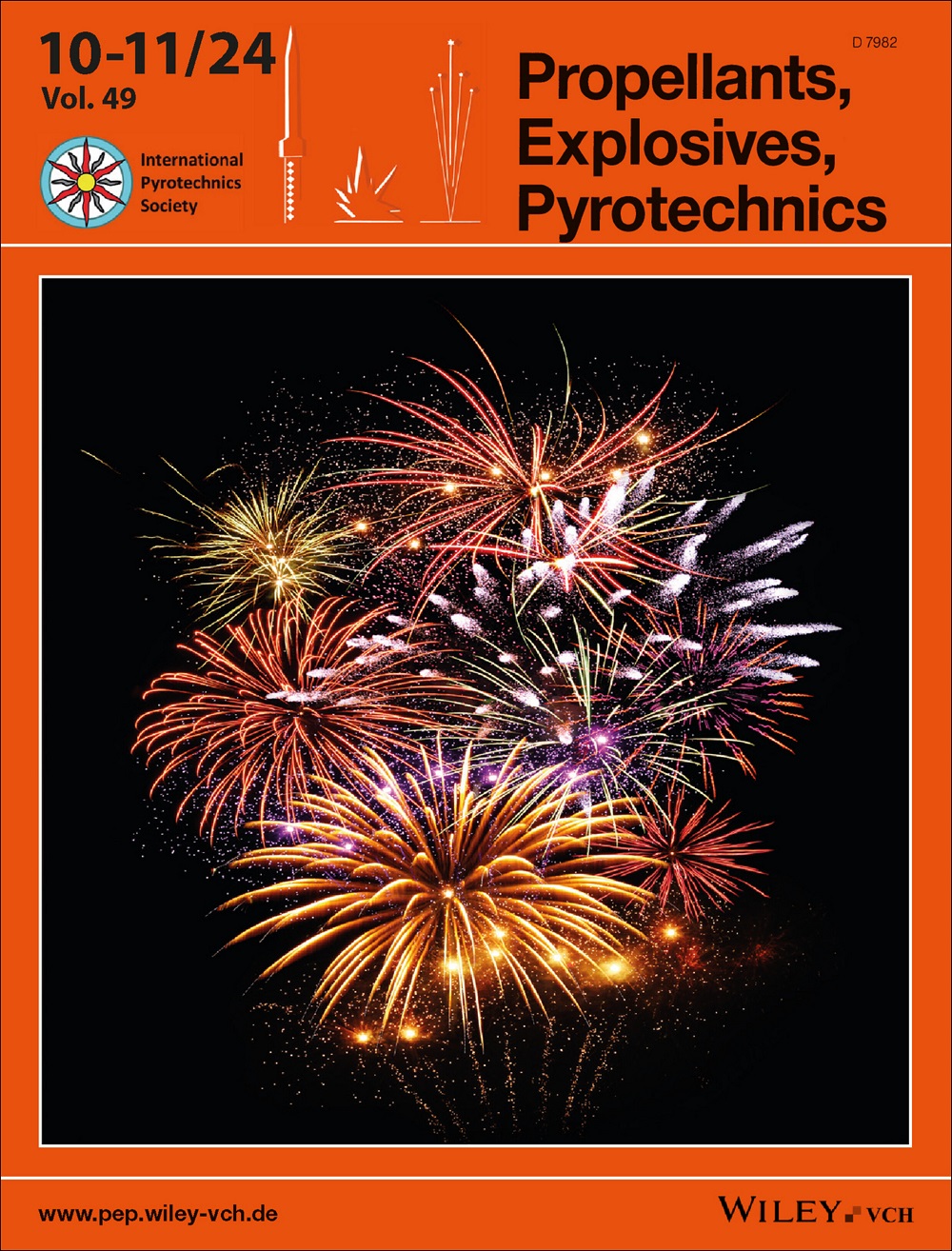Investigation of thermal damage in explosive bridgewire detonators via discrete element method simulations
IF 2
4区 工程技术
Q3 CHEMISTRY, APPLIED
引用次数: 0
Abstract
Exploding bridgewire (EBW) detonators are used to rapidly and reliably initiate energetic reactions by exploding a bridgewire via Joule heating. While the mechanisms of EBW detonators have been studied extensively in nominal conditions, comparatively few studies have addressed thermally damaged detonator operability. We present a mesoscale simulation study of thermal damage in a representative EBW detonator, using discrete element method (DEM) simulations that explicitly account for individual particles in the pressed explosive powder. We use a simplified model of melting, where solid spherical particles undergo uniform shrinking, and fluid dynamics are ignored. The subsequent settling of particles results in the formation of a gap between the solid powder and the bridgewire, which we study under different conditions. In particular, particle cohesion has a significant effect on gap formation and settling behavior, where sufficiently high cohesion leads to coalescence of particles into a free‐standing pellet. This behavior is qualitatively compared to experimental visualization data, and simulations are shown to capture several key changes in pellet shape. We derive a minimum and maximum limit on gap formation during melting using simple geometric arguments. In the absence of cohesion, results agree with the maximum gap size. With increasing cohesion, the gap size decreases, eventually saturating at the minimum limit. We present results for different combinations of interparticle cohesion and detonator orientations with respect to gravity, demonstrating the complex behavior of these systems and the potential for DEM simulations to capture a range of scenarios.通过离散元法模拟研究爆炸桥丝雷管的热损伤
起爆桥丝(EBW)雷管通过焦耳加热起爆桥丝,从而快速可靠地引发高能反应。虽然对 EBW 雷管在额定条件下的机理进行了广泛研究,但针对热损伤雷管可操作性的研究相对较少。我们采用离散元素法 (DEM) 模拟,明确考虑了压制炸药粉末中的单个颗粒,对具有代表性的 EBW 雷管中的热损伤进行了中尺度模拟研究。我们使用了一个简化的熔化模型,其中固体球形颗粒发生均匀收缩,流体动力学被忽略。颗粒随后的沉降导致固体粉末和桥丝之间形成间隙,我们在不同条件下对其进行了研究。特别是,颗粒的内聚力对间隙的形成和沉降行为有显著影响,足够高的内聚力会导致颗粒凝聚成一个独立的颗粒。我们将这种行为与实验可视化数据进行了定性比较,结果表明模拟捕捉到了颗粒形状的几个关键变化。我们利用简单的几何参数推导出熔化过程中间隙形成的最小和最大限制。在没有内聚力的情况下,结果与最大间隙大小一致。随着内聚力的增加,间隙减小,最终在最小极限处达到饱和。我们展示了颗粒间内聚力和雷管相对于重力方向的不同组合的结果,证明了这些系统的复杂行为以及 DEM 模拟捕捉各种情况的潜力。
本文章由计算机程序翻译,如有差异,请以英文原文为准。
求助全文
约1分钟内获得全文
求助全文
来源期刊

Propellants, Explosives, Pyrotechnics
工程技术-工程:化工
CiteScore
4.20
自引率
16.70%
发文量
235
审稿时长
2.7 months
期刊介绍:
Propellants, Explosives, Pyrotechnics (PEP) is an international, peer-reviewed journal containing Full Papers, Short Communications, critical Reviews, as well as details of forthcoming meetings and book reviews concerned with the research, development and production in relation to propellants, explosives, and pyrotechnics for all applications. Being the official journal of the International Pyrotechnics Society, PEP is a vital medium and the state-of-the-art forum for the exchange of science and technology in energetic materials. PEP is published 12 times a year.
PEP is devoted to advancing the science, technology and engineering elements in the storage and manipulation of chemical energy, specifically in propellants, explosives and pyrotechnics. Articles should provide scientific context, articulate impact, and be generally applicable to the energetic materials and wider scientific community. PEP is not a defense journal and does not feature the weaponization of materials and related systems or include information that would aid in the development or utilization of improvised explosive systems, e.g., synthesis routes to terrorist explosives.
 求助内容:
求助内容: 应助结果提醒方式:
应助结果提醒方式:


